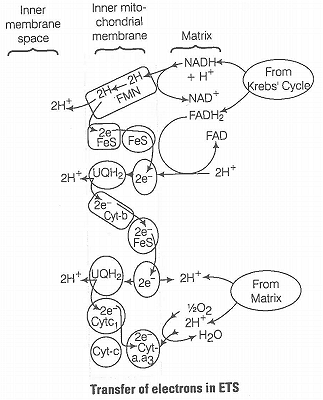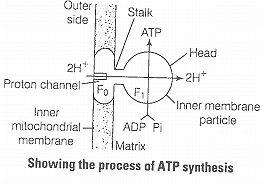Krebs’ cycle occurs in the matrix of mitochondria. It is depicted in the following series of reactions.
Electron transport chain is carried out in the inner mitochondria membrane
The inner mitochondrial membrane is specific about possessing proton (H+) and electron (e-) acceptors in a particular sequence called electron transport chain. It has four enzyme complexes.
The electrons either follow the pathway of complexes I, III and IV or II, III and IV depending upon the substrates from Krebs' cycle
The transfer of electrons and hydrogen atoms takes placein the following way
Complex I Consists of flavoproteins of NADH dehydrogenase (FPN) of which FMN is the prosthetic group. Combined with the flavoprotein is non-heme iron of NADH dehydrogenase. This complex spans inner mitochondrial membrane and is able to translocate protons across it from matrix side to outer side.
Complex II Consists of flavoprotein of succinate dehydrogenase, of which FAD is the prosthetic group. Combined with the flavoprotein is non-heme iron of succinate dehydrogenase.
Between complexes II and III is the mobile carrier coenzyme-Q (Co-Q) or ubiquinone (UQ).
Complex III Consists of cytochrome-b and cytochrome- C1 . Associated with cytochrome- b is non-heme iron of complex III. Between complexes III and IV is the mobile carrier cytochrome-c.
Complex IV Consists of cytochrome-a and cytochrome- a3 , and bound copper that are required for this complex reaction to occur. This cytochrome also called cytochrome oxidase, is the only electron carrier in which the heme iron has a free ligand that can react directly with molecular oxygen.
Thus, hydride ions are transferred from the substance to be oxidised to NAD+. From NAD+ the hydrogen atoms are transferred to FMN of flavoprotein 1 (Fp'N). After FMN the hydrogen atom undergoes ionisation, i.e., it splits into an electron and a proton.
In further stages there is no longer a transfer of hydrogens but of electrons. The electron passes to co-enzyme- Q, and from co-enzyme Q to cytochromes- b, c1 , c ,a and a3. The proton is released free.
As the hydrogen atom or electron passes down by particle the chain, there is simultaneous oxidation of one coenzyme and reduction at another steps. Oxygen is able to diffuse indside the mitochondria.
It is converted to anionic form , combines with and forms metabolic water reduced co-enzyme helps in pushing out three pairs of H+ to outer chamber while sends two pairs of H+ to outer chamber.
Oxidative phosphorylation is the synthesis of energy rich ATP molecules, with the heip of energy liberated during oxidation of reduced co-enzyme produced in respiration. The enzyme required for this synthesis is called ATP synthase present in inner mitochondria membrane.
The following figures shows this process


